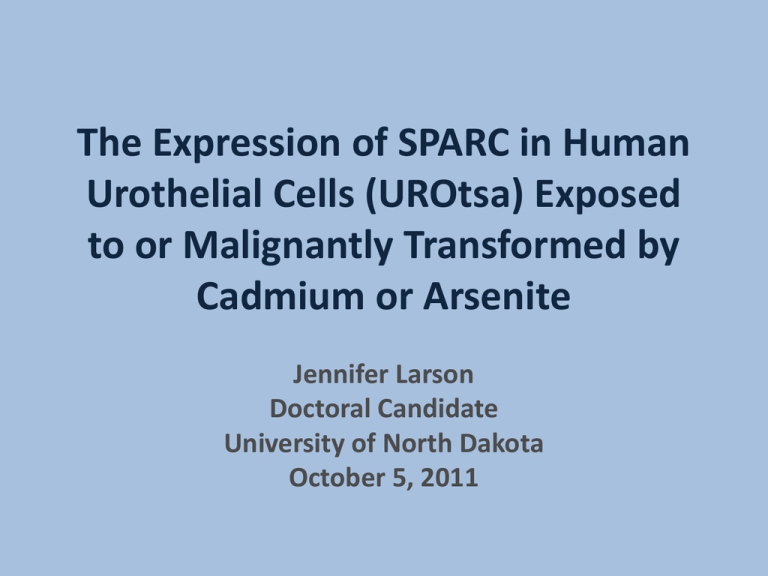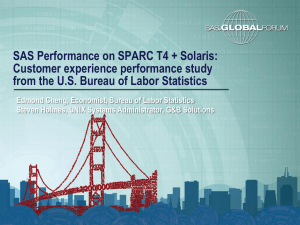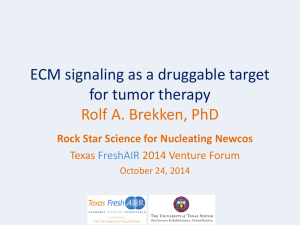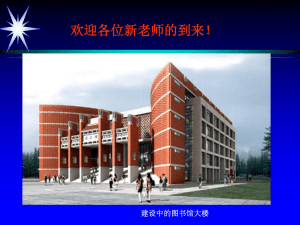Larson
advertisement

The Expression of SPARC in Human Urothelial Cells (UROtsa) Exposed to or Malignantly Transformed by Cadmium or Arsenite Jennifer Larson Doctoral Candidate University of North Dakota October 5, 2011 Outline • • • • • • Background Info Purpose Methods Results Conclusions Future directions Bladder Cancer • Transitional cell carcinoma of the bladder is the 9th most common cancer worldwide and the 4th in U.S (Bischoff & Clark, 2010) • Highest cost per patient of all cancers (Sullivan et al., 2010; Jacobs et al., 2010) • Bladder cancer was the first cancer in which industrial carcinogens were found to play the major role in disease causation Link between exposure to aromatic amines and development of bladder cancer in factory workers (Rehn, 1895) • Cd⁺² and As⁺³ are human carcinogens (IARC, 1993; IARC, 1980) and linked to the development of bladder cancer (Steinmaus et al., 1994 & 2000) • Association between cigarette smoking and bladder cancer 2-4 times increased risk (Clavel et al., 1989; Morrison et al., 1984; Silverman et al., 1992) UROtsa Cell Line • Derived from the urothelium lining the ureter of a 12 year-old female. • Immortalized with SV40 large T-antigen (Perzoldt et al., 1995) • Cd⁺² and As⁺³ are able to cause the malignant transformation of UROtsa cells (Sens et al., 1994 & 2000) Generated 7 different Cd+2 & 6 different As+3 cell lines. UROtsa Parent UROtsa Cd⁺² UROtsa As⁺³ Sens et al. Toxicological Sciences (2004) • UROtsa parent cells are nontumorigenic: Do not grow in soft agar No not form tumors in nude mice • Transformed cell lines are tumorigenic: Grow in soft agar Form tumors in nude mice SPARC • Secreted Protein, Acidic and Rich in Cysteine Also known as: Osteonectin & BM-40 • Belongs to the Matricellular group of proteins Secreted macromolecules that interact with cell-surface receptors, ECM, and/or growth factors and proteases, but do NOT have structural roles Known to bind to structural matrix proteins • Collagen and Vitronectin Found in tissues undergoing repair/remodeling (Salonen et al. 1990) Upregulated during embryological development (Sage et al., 1989) Other matricellular proteins include: • • • • • • Thrombosponbin 1 & 2 Tenascin C & X Osteopontin CTGF Testican 1, 2, & 3 (SPARC-related protein) Hevin (SPARC-related protein) SPARC • 3 General functions of SPARC: 1. De-adhesion: • Exogenous SPARC inhibits cell spreading and cell attachment (Sage et al. 1989) • Disassemble focal adhesions (Murphy-Ullrich et al. 1995, Murphy-Ullrich 2001) • Reorganizes actin stress fibers to periphery of cell (Murphy-Ullrich et al. 1995) • May play a role in cell migration 2. Anti-proliferation: • Cell cycle inhibitor (Funk & Sage 1991, 1993; Sage et al. 1995) • Promoted prostate cancer cell migration (De et al. 2003) and stimulated fibroblasts during myocardial infraction (Wu et al. 2006) • May play a role in cell migration 3. Regulation of ECM & growth factors: • Binds to many ECM components (Brekken & Sage 2000) • Known activator of MMP-2 (Tremble et al. 1993) • Regulates PDGF, VEGF, & TGF-β1 expression (Raines et al, 1992, Kuppricon et al. 1998, Abe et al. 2004, Hasselaar & Sage 1992, Lane & Sage 1994) • After exogenous treatment, capable of inducing the expression of SPARC • May play a role in the progression of metastatic tumors Purpose • To determine the role SPARC plays in the formation and progression of bladder cancer. SPARC Expression in UROtsa Cell Lines & Normal Bladder Tissue Larson et al 2010 SPARC Expression in Normal and Cancerous Bladder Tissue Normal Bladder Tissue High Grade Carcinoma Larson et al 2010 SPARC Expression after Treatment with MS-275 & 5-AZC • Possible role of epigentic modification? • 24, 48, and 72h treatment 48h shown • MS-275 is a histone deacetylase inhibitor Prevents acetyl groups from being removed from histones • 5-Aza-2’-deoxycytidine (5-AZC) is a methylation inhibitor Inhibits the methylation of histones • Conclusion: No change in SPARC expression Larson et al 2010 SPARC Expression after Drug Combination Treatment • Treatment with both MS-275 & 5-AZC for 72hrs • Conclusion: No change in SPARC expression Larson et al 2010 SPARC Expression after Treatment with As⁺³ & Cd⁺² Larson et al 2010 SPARC Expression during Transformation of UROtsa Cell Lines Summary: SPARC Expression • Moderate SPARC expression in Normal Tissue • Low or undetectable SPARC expression in Cancerous/Tumor Tissue • SPARC expression does not appear to be regulated epigenetically in our system • SPARC mRNA and protein expression decreases with increasing concentrations of As3+ and Cd2+ SPARC Transfection • 4 cell lines were chosen for stable transfection of SPARC: As#3, As#6, Cd#1, Cd#4 • All cell lines were characterized: mRNA Protein Secretion of SPARC protein Growth Migration SPARC Transfection • 4 cell lines were chosen for stable transfection of SPARC: As#3, As#6, Cd#1, Cd#4 SPARC Expression within Cultured Media • All cells were grown in Serum Free growth media Media was harvested, centrifuged, and filtered Protein was precipitated from growth media Loaded equal total protein per lane • SPARC transfected cell lines had similar staining SPARC expression does not appear to be matrix incorporated Growth: MTT Cell Line Doubling Time Parent 33.2 ± 0.8 h As#3 33.3 ± 1.4 h As#3-SPARC 27.4 ± 1.0 h* As#6 21.6 ± 1.6 h As#6-SPARC 25.6 ± 0.5 h Cd#1 27.8 ± 0.6 h Cd#1-SPARC 23.8 ± 0.6 h* Cd#4 20.7 ± 1.1 h Cd#4-SPARC 22.0 ± 0.6 h Cao et al 2010; Somji et al 2010 Migration • Wound/Scratch assay: • • • • • • Cells were grown to confluence Conditions: Untx or treated with Mitomycin C (MMC) for 2h Scratch performed with 200ul pipette tip Cells were rinsed with PBS 2x’s Pictures taken at 0h and 24h MTT performed to determine cell viability • Determine best concentration of MCC to prevent cell death • Performed in duplicate Migration • Wound/Scratch assay: Migration • Transwell Migration assay: • Top chamber = 2.4 x 105 cells/ml in serum free media • Bottom chamber = 1.5% fetal calf serum • 8h incubation for migration • Count total number of cells on insert • Remove cells from top of insert and count remaining • Total of 20 fields per insert, performed in duplicate Migration • Transwell Migration assay: * * * * * ** ** Conclusions • Expression of SPARC is not epigenetically regulated in our system • SPARC expression decreased with treatment with Cd2+ & As3+ • SPARC tranfections: Secrete SPARC into media 2 transfected cell lines had decreased migration Future Directions • Assess the ability of SPARC transfected cell lines to form tumors in nude mice Tumor size Subcutaneous vs. intraperitoneal tumor formation Expression of SPARC in tumor • Assess the structural differences of SPARC between UROtsa Parent and transfected cell lines Glycosylation Post-translational modifications • Characterization of the promoter elements that turn off SPARC expression with treatment of Cd2+ & As3+ Acknowledgements • Dr Jane Dunlevy Holly Hewitt • • • • • Dr Don Sens Dr Mary Ann Sens Dr Seema Somji Dr Scott Garrett Dr XuDong Zhou Questions? SPARC • First identified as the most abundant non-collagenous component of bone (Termine et al.1981) • Highly conserved among different species Human gene has 92% homology with mice • Predicted molecular mass of 32,511 Daltons Secreted form of the protein migrates at 43kD on SDS-PAGE • Due to addition of carbohydrates (Sage et al. 1984) Bradshaw & Sage 2001 SPARC Expression in Mouse Heterotransplants Larson et al 2010 SPARC Expression in Cancerous Tissue • Tumor Promoter: Increased expression of SPARC • Brain: Glioblastomas, Astrocytomas, Meningioma • Breast: Invasive ductal carcinoma • Lung: NSCLC, squamous cell carcinoma, adenocarcinoma • Pancreas: Pancreatic ductal adenocarcinoma • Skin: Melanoma • Tumor Suppressor: Decreased expression of SPARC • • • • • • Brain: Neuroblastoma Ovary: carcinoma Lung: NSCLC & SCLC Pancreas: PDAC Skin: Melanoma Uterus: Cervical & endometrial carcinoma Epigenetic Regulation of SPARC • Ovarian cancer: Treatment with the demethylating agent 5-aza-2'-deoxycytidine (5AZC) rescued SPARC mRNA and protein expression in 9 ovarian cancer cell lines 1 cell line showed a significant increase in SPARC mRNA after TSA treatment, histone deacetylase inhibitor (Socha et al. 2009) • Colon cancer: Induction of SPARC was observed in 5 of the 7 cell lines after 5-AZC treatment (Yang et al. 2007) • Non-small cell lung cancer (NSCLC): SPARC expression was restored after 5-AZC treatment in all 11 NSCLC cell lines (Suzuki et al. 2005) • Pancreatic adenocarcinoma: SPARC mRNA expression was restored in seven 7 of 8 cell lines after 5-AZC treatment SPARC expression was not restored 1 cell line after 5-AZC treatment did not restore the SPARC expression. Treatment with an HDAC inhibitor TSA or with a combination of 5-AZC and TSA did not induce SPARC expression (Sato et al. 2003)







